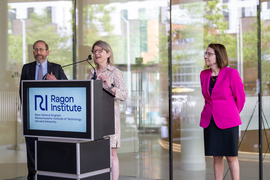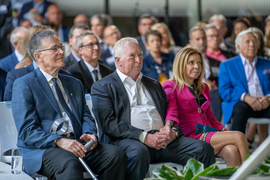Leaders from MIT, Harvard University, and Mass General Brigham gathered Monday to celebrate an important new chapter in the Ragon Institute’s quest to harness the immune system to prevent and cure human diseases.
The ceremony marked the opening of the new building for the Ragon Institute of Mass General, MIT, and Harvard, located at 600 Main Street in the heart of Cambridge’s Kendall Square, where its multidisciplinary group of researchers will expand on the collaborations that have proven impactful since the Institute’s founding in 2009.
“Fifteen years ago, the Ragon Institute started with transformative philanthropy from Terry and Susan Ragon,” Ragon Institute Director and MIT professor of the practice Bruce Walker said. “Initially, it was an experiment: Could we bring together scientists, engineers, and medical doctors to pool their creative knowledge and cross-disciplinary specialties to make advances against the greatest global health problems of our time? Now, 15 years later, here we are celebrating the success of that experiment and welcoming the next phase of the Ragon Institute.”
The institute’s new building features five floors of cutting-edge, dedicated lab space and more than double the floor area of the previous facilities. The open, centralized layout of the new building is designed to empower cross-disciplinary research and enable discoveries that will lead to new ways to prevent, detect, and cure diseases. The expanded space will also allow the Ragon Institute to bring in more scientists, researchers, biologists, clinicians, postdocs, and operational staff.
“Cross-disciplinary collaboration is a hallmark of the Ragon Institute, and that is really how you do transformational research and breakthrough science at scale — what everyone talks about but few actually achieve,” said Mass General Brigham President and CEO Anne Klibanski. “Partnerships between health care and academia accelerate these breakthroughs and foster innovation. That is the model of scientific discovery this whole area represents, that Boston and Massachusetts represent, and that this institute represents.”
In addition to state-of-the-art lab space, a third of the new building is open for public use. The Ragon Institute’s leaders expressed a commitment to engaging with the local Cambridge community and believe the institute’s success will further strengthen Kendall Square’s innovation ecosystem.
“As a relative newcomer, I see this elegant new building as an inspiring vote of confidence in the future of Kendall Square,” MIT President Sally Kornbluth said. “I gather that over a few decades, thanks in part to many of you here today, Kendall Square was transformed from a declining postindustrial district to the center of a region that is arguably the biotech capital of the world. I believe we now have an opportunity to secure its future, to make sure Kendall Square becomes an infinitely self-renewing source of biomedical progress, a limitless creative pool perpetually refreshed by a stream of new ideas from every corner of the life sciences and engineering to unlock solutions to the most important problems of our time. This building and this institute embody that vision.”
The Ragon Institute is a collaborative effort of Mass General Brigham, MIT, and Harvard. It was founded in 2009 through support from the Phillip T. and Susan M. Ragon Foundation with the initial goal of developing an HIV vaccine. Since then, it has expanded to focus on other global health initiatives — from playing a vital role in Covid-19 vaccine development to exploring the rising health challenges of climate change and preparing for the next pandemic.
The institute strives to break down siloes between scientists, engineers, and clinicians from diverse disciplines to apply all available knowledge to the fight against diseases of global importance.
During the ceremony, Phillip (Terry) Ragon ’72 discussed the origins of the Institute and his vision for accelerating scientific discovery.
“With Bruce [Walker], I began to see how philanthropy could really make a difference and how we could power a different model that we thought could be particularly effective,” Ragon said. “The fundamental idea was to take an approach like the Manhattan Project, bringing the best and brightest people together from different disciplines, with flexible funding, and leave them to be successful. And so here we are today.”
Ragon Institute faculty are engaged in challenges as varied as developing vaccines for tuberculosis and HIV, cures for malaria, treatments for neuroimmunological diseases, a universal flu vaccine, and therapies for cancer and autoimmune disorders — with the potential to impact billions of lives.
The new building’s opening followed additional funding from Terry and Susan Ragon, which came in recognition of the Ragon Institute’s expanding mission.
“[Through this partnership], we’ve accomplished more than we realized we could, and that’s shown in the scientific progress that the Ragon Institute has achieved,” said Harvard University interim president Alan Garber. “To pull this off requires not only scientific brilliance, but true leadership.”
Walker, the Institute’s founding director, has spent his entire career caring for people living with HIV and studying how the body fights back. He has helped establish two cutting-edge research institutes in Africa, which continue to train the next generation of African scientists. The international reach of the Ragon Institute is another aspect that sets it apart in its mission to impact human health.
“Today we launch the next 100 years of the Ragon Institute, and we’re fortunate to work every day on this enormously challenging and consistently inspiring mission,” Walker said. “We’re motivated by the belief that every day matters, that our efforts will ultimately alleviate suffering, that our mission is urgent, and that together, we will succeed.”












